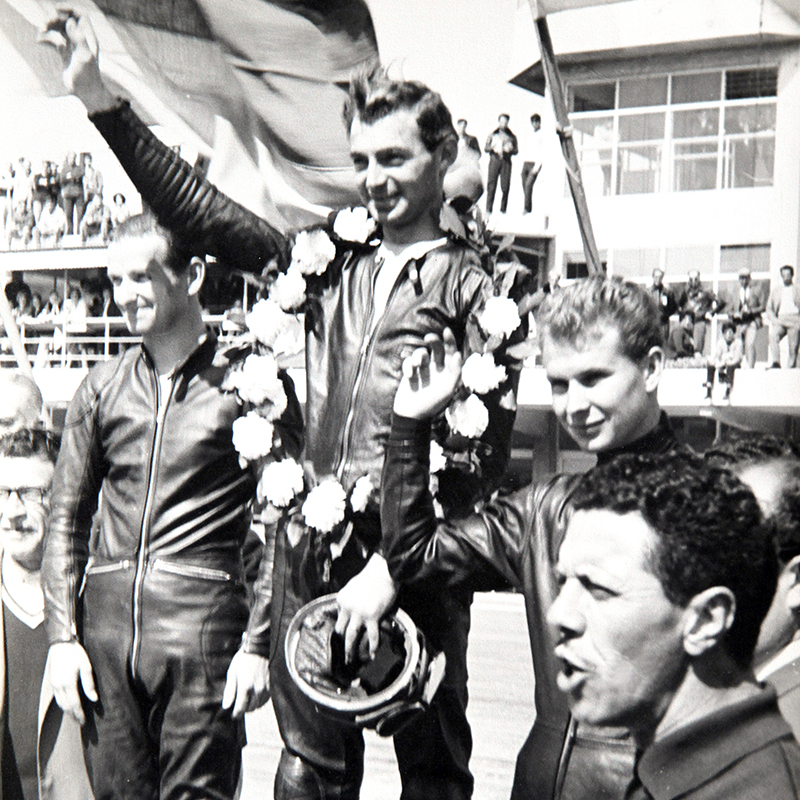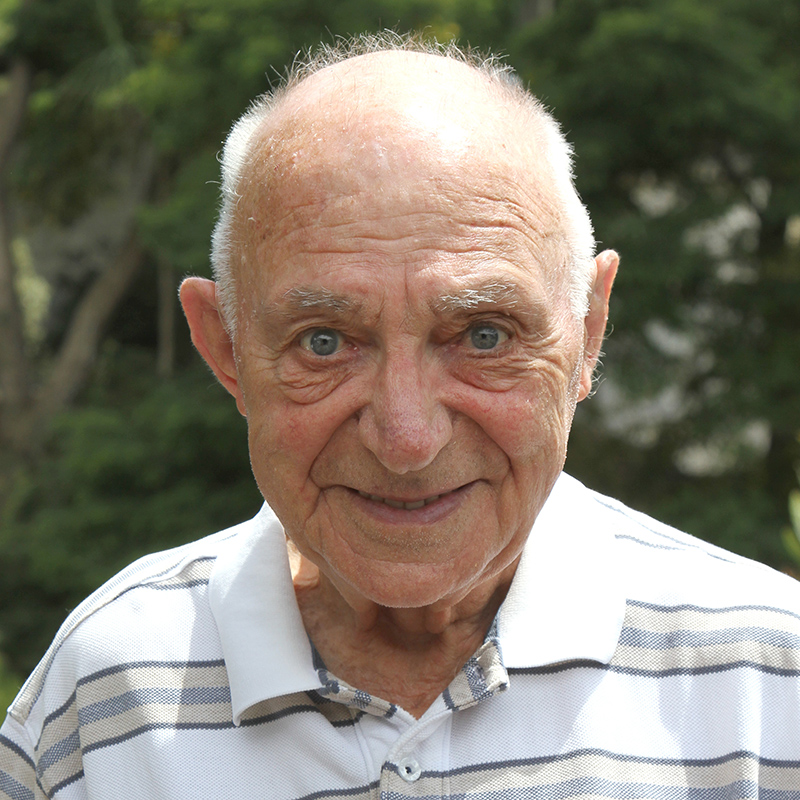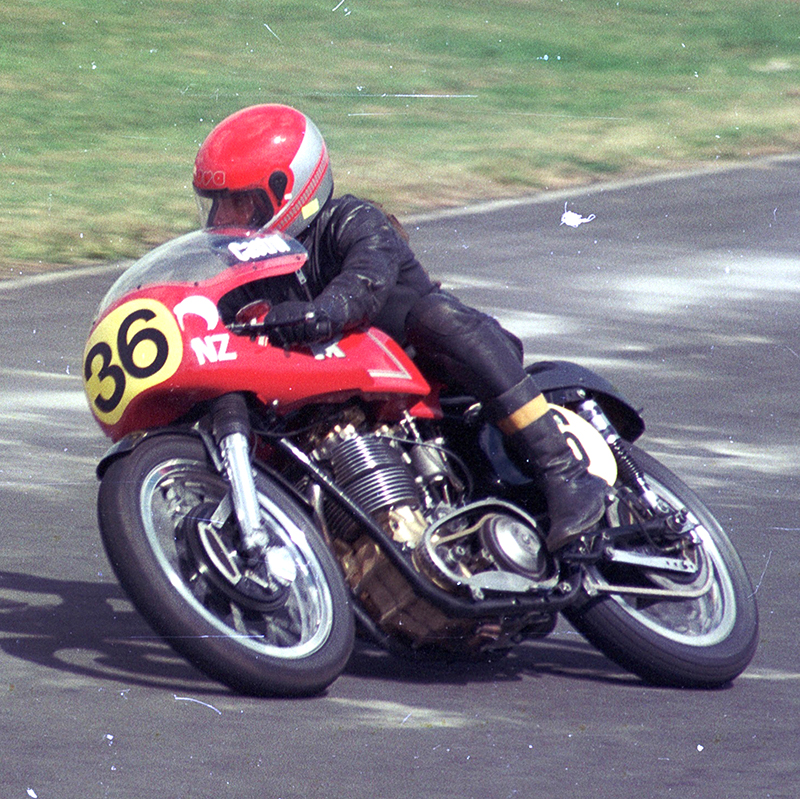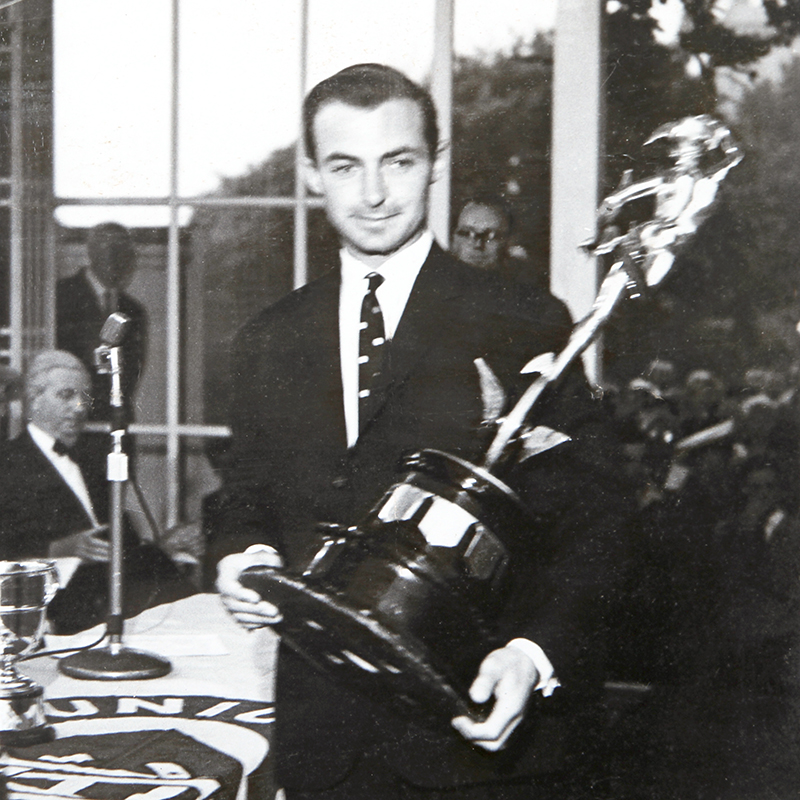Kiwi great Hugh Anderson was inducted as a MotoGP Legend at the Australian round of the world championship. This is why.
Born on 18 January 1936, and raised on a New Zealand dairy farm, Hugh Robertson Anderson played rugby league, began his working life in a foundry before moving into a coal mine. He loved motorcycles and knew from as young as 10-years old that he’d one day race the Isle of Man TT.
At 17 years old, Anderson won every race he entered during his first off-road race meeting, and not long after, riding an eight-year-old bike purchased in pieces, he also won the first road race he entered.
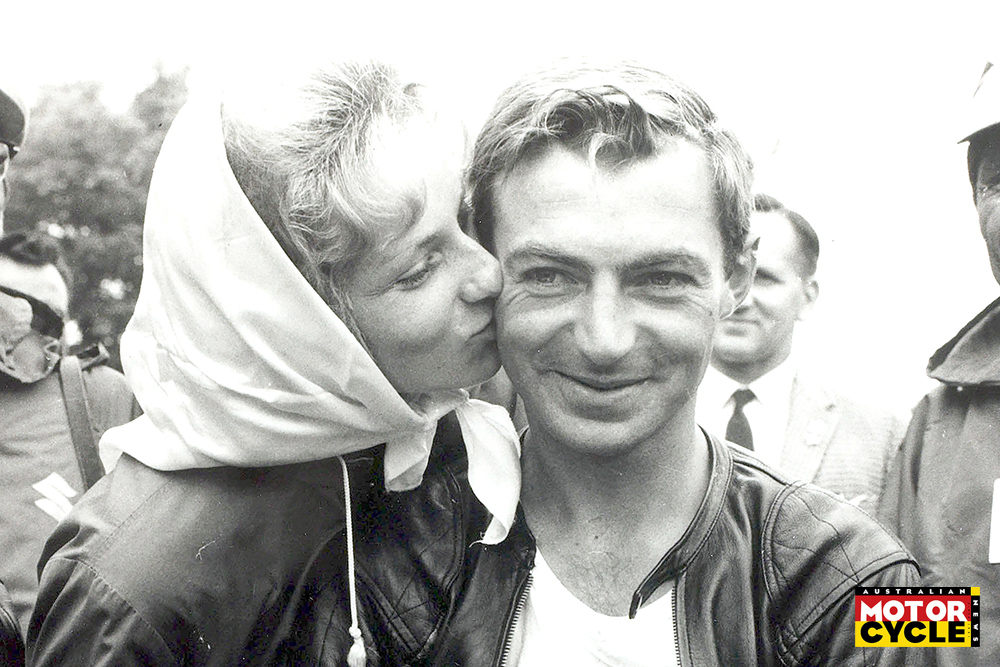
A multitude of wins and races culminated in double Senior and Junior victories at the 1960 New Zealand TT and a one-way ticket to England, aged 24, to take on the world. Three weeks after arriving in the UK, he qualified fourth at the Austrian GP, and finished seventh. Anderson won at Madrid, and finished seventh again at the French GP. The same year, Anderson’s 14-year-old dream came true when when he made his debut at the Isle of Man in the 350cc Junior class.
“I like things in writing, and John Hempleman took me around and told me where to brake and what gear to use on every corner, and I wrote it all down. I didn’t see the sense going past Ballacraine which is seven miles out if you didn’t know every part of that track. So I got that right then another section right, and another. So many people have spoken about doing 200 laps on a motorcycle but I didn’t see the point, I didn’t even have a motorbike, or a car, or a van! All I had was a borrowed pushbike.”
Problems were afoot as Anderson had two crippled motorcycles, luckily Percy Coleman arranged for an AJS 7R, but with no transport he had to cycle down to pick it up.
After setting an impressive 93mph (150km/h) practice lap, the valve springs broke during the race while holding fifth in the Junior TT.
“I was sleeping absolutely no more than four hours a night as I’d been reading my notes until two in the morning, and I had to be up at 4am to get ready for practice,” he recalls. “You see, food and sleep didn’t matter, honestly, it didn’t matter because the other job is more important.”
In 1961 Anderson rode the new Suzuki RV61 250 to finish tenth, he was eighth until stopping to change the plugs. The Isle of Man is a treacherous place when things go wrong but Anderson made the decision to continue racing the Mountain Course in 1962, even after seven people were killed including two friends, and had to pack up fellow kiwi Colin Meehan’s (Union Mills, June 6, 1962) personal effects. Yet the dream still burned hot.
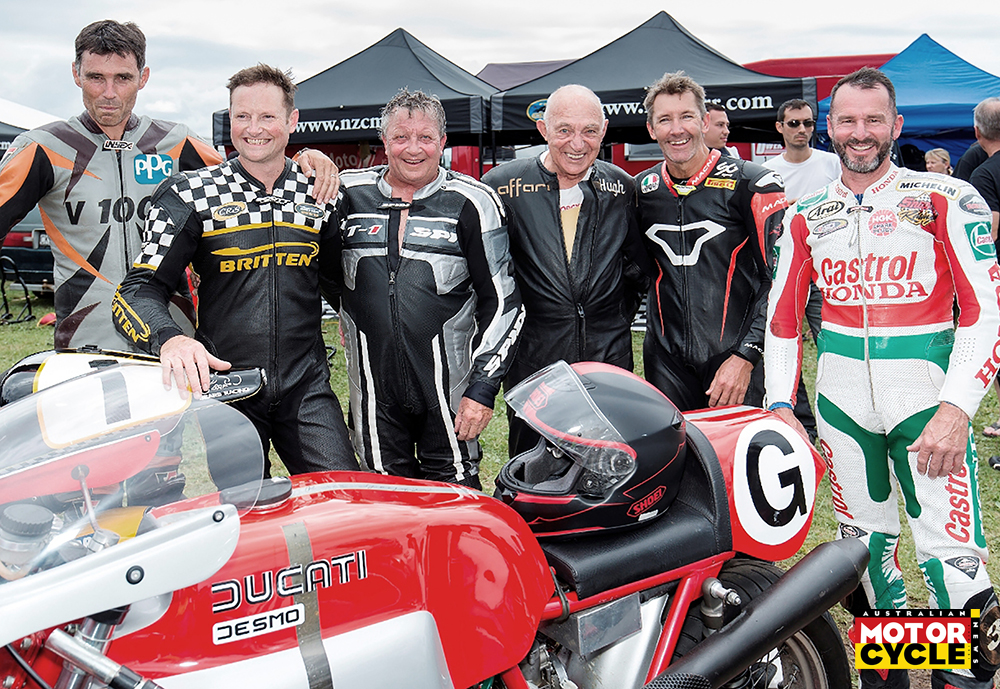
Hugh alongside some fellow NZ racing royalty, and a cameo from Aussie Troy Bayliss!
“At the end of that I had to decide whether to go home or stay? When you declare, and believe by accepting death, you lose the fear of it. You go out there knowing totally that you could be killed, and you still want to do it because it’s more important than life itself. I made the decision that I was staying as if I died, my life had no value anyhow because all I had ever wanted to do was race motorcycles at the Isle of Man from when I was 10.”
By 1963 he knew the island well and won the 125cc Ultra-Lightweight race by 1m20s from teammate Frank Perris. Anderson encountered a tough 1964 Isle of Man despite an International 50cc TT win, when he allowed the suspension to work properly by loosening off over-tight oil seals on the fork stanchions. The 125cc Ultra-Lightweight TT was a different story however as they had a lot of reliability trouble. The maximum revs were lifted from 13,500rpm to 14,000rpm, but the crankshafts weren’t reliable at that speed. If it went slightly over 14,000rpm it would fail, which is exactly what happened while in third position.
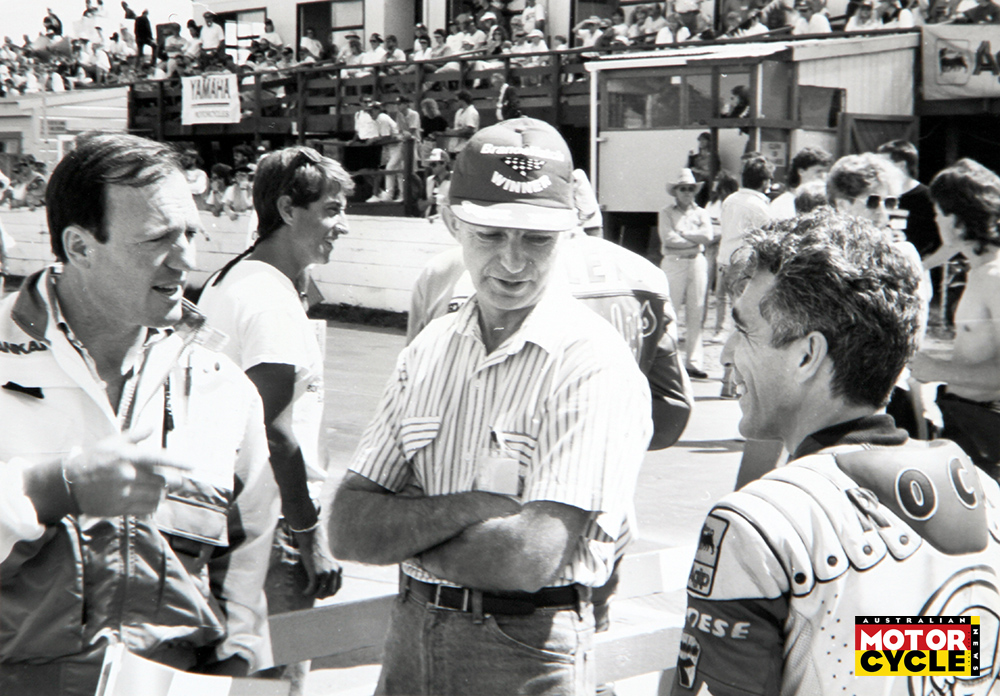
At the 1990 Manfeild WorldSBK round with Graeme Crosby. Frenchman Raymond Roche is the rider
Anderson finished the 1965 Ultra-Lightweight TT in fifth position after going quite well in practice, but he and the new mechanic had a start-line argument about main jets and spark plug heat range, to the point Anderson raced with too-large a main jet with a spark plug too cold for the jet size. He enjoyed a 10-second lead halfway around the circuit but going up the mountain, the plugs oiled up due to less oxygen, causing him to stop and change both plugs.
“I carried on, taking 48 seconds off the lap record and finished fifth – I was the fastest out there and I should have won it, I should have won three Isle of Man TTs instead of two.”
Luigi Taveri won the 50cc race with Anderson second on the tiny twin-cylinder machines, although despite the high winds he raised the lap record to 82.46mph (133km/h).
Anderson took no wins in a very difficult 1966 year with Suzuki, with a best Grand Prix result of third in the Isle of Man Ultra-Lightweight TT on the RT66. He only managed two clean practice laps on the 125 after continuing machinery issues. He still carries weight on his shoulders following his final TT as he feels if he’d adopted a better attitude he would have finished second.
“In 1966 I had decided to retire so it was my last time on the island and I wanted to enjoy it. Just the Isle of Man circuit and me.”
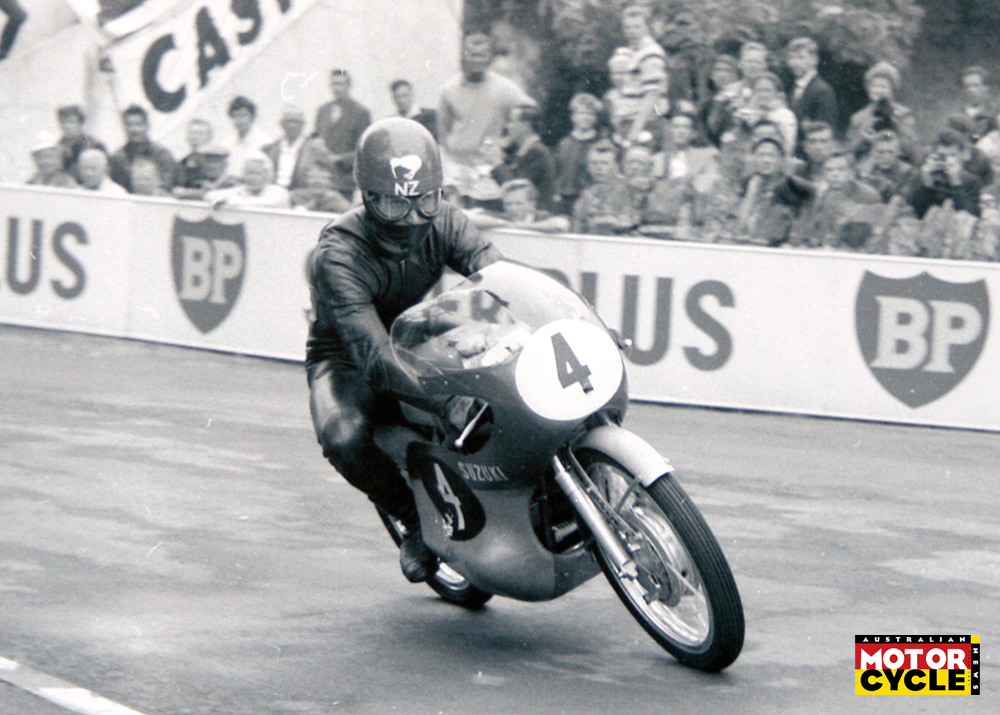
Two of Hugh’s world titles – and 16 wins – were on Suzuki’s 125
The Suzuki start
Shell was associated with both Hugh Anderson and Suzuki, so an arrangement was made through Lew Ellis to race an experimental 250cc Suzuki RV61 at the 1961 Isle of Man TT, which Anderson raced to 10th place and was promptly offered a factory contract for 1962.
He also gained the support of the AJS and Matchless factories for all the major British events that didn’t clash with the world championship series, and rode his own 500cc Norton on any free weekends.
In typical kiwi style, he got straight into solving the many reliability problems facing Suzuki. “I knew there were problems and I went about solving them,” he remembers. “The fuel supply was intermittent and the engine was holding back because the plugs were too hot. I had to keep pressing the cut-out switch to keep it cooler (while racing). You had to work these things out, you couldn’t just sit on it.
“One time I asked them to leave the bike until after breakfast and I came back and dismantled the carburettors and there were these very fine pieces of fibreglass inside. It turns out that Japanese petrol did not melt the fibreglass, but British fuel did. Suzuki were delighted of course as I’d also helped them improve their bike, in several ways I gave them credibility.”
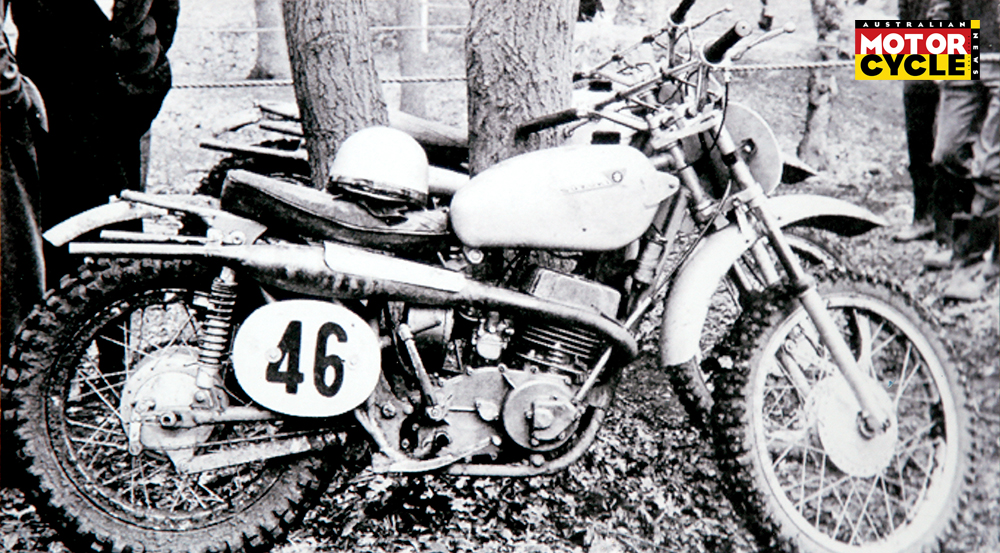
In 1967, Hugh became the first Suzuki rider to finish a world MX event
After learning to ride big four-stroke singles, somehow Anderson found a way to extract the most out of his tiny Suzukis.
“In 1965 the 50cc machines maximum revs were 17500rpm, they had 14 gears, one up and 13 down,” Anderson explains. “At The Belgium GP of that year my bike was geared for an amazing 115mph (185kmh). You give an engine what it wants, not what you think it should have, which is why I finished more races than other team members.”
Changing up to 14 ratios on a tiny 50cc motorcycle all the while trying to race against other riders, at speed, and think of so many other things going on must have been a massive challenge.
“If you didn’t change down enough then you wouldn’t be in the right rev range for the next corner, so it was pretty important. If you were in 14th gear on a straight on a 50cc and you had to change down to third for the next corner you had to be good at counting as you had to change down 11 times! It also happened on the 125, however that had less gears than the 50cc bikes.”
Anderson recalls the Suzuki 125 (and the 50cc) had an ‘ample powerband’ of 500rpm, which was a lot in those days for a tiny two-stroke, although had to slip the clutch to lift the revs 250rpm with each shift exiting corners.
- Alongside a 1937 model BSA M23
- Plying his mechanical skills on a Manx Norton
He would go out and practice with a rich, over-oiled engine and then to increase reliability, at night he would rub the piston down to reduce the high spots. The next day in practice he would go faster and have it leaner, then that night he’d rub the piston down more, increasing the clearance.
“So come race day with a wee bit of luck you had guessed how much you could reduce the jet size according to how much you had taken off the piston the previous two nights. Then hopefully it would go like a rocket.”
But the Japanese team mechanics would often chase only maximum horsepower and the resultant unreliable engine would seize during a race. A problem which continually hounded the team and ultimately cost them their star rider.
So how did Hugh keep the Japanese engineers away from the engine? “I stayed there until two o’clock in the bloody morning if I had work to do. I was the last to go home and the first to get up at five or six o’clock in the morning, I can assure you.”
Four Key Seasons
Hugh Anderson became a double world champion in 1963.
“I had ridden in the Spanish Grand Prix gaining second in the 50cc class, the West German Grand Prix at Hockenheim, and the French Grand Prix at Clermont-Ferrand, and that was the key,” he says. “At Hockenheim I won the 50cc race where there are a lot of trees, forestry – oxygen, so bigger jets. I was on to it pretty smartly and won the 50cc race leaving me in a comfortable position in the category. Ernst Degner was fast as well, he won the 125 race, I was second.”
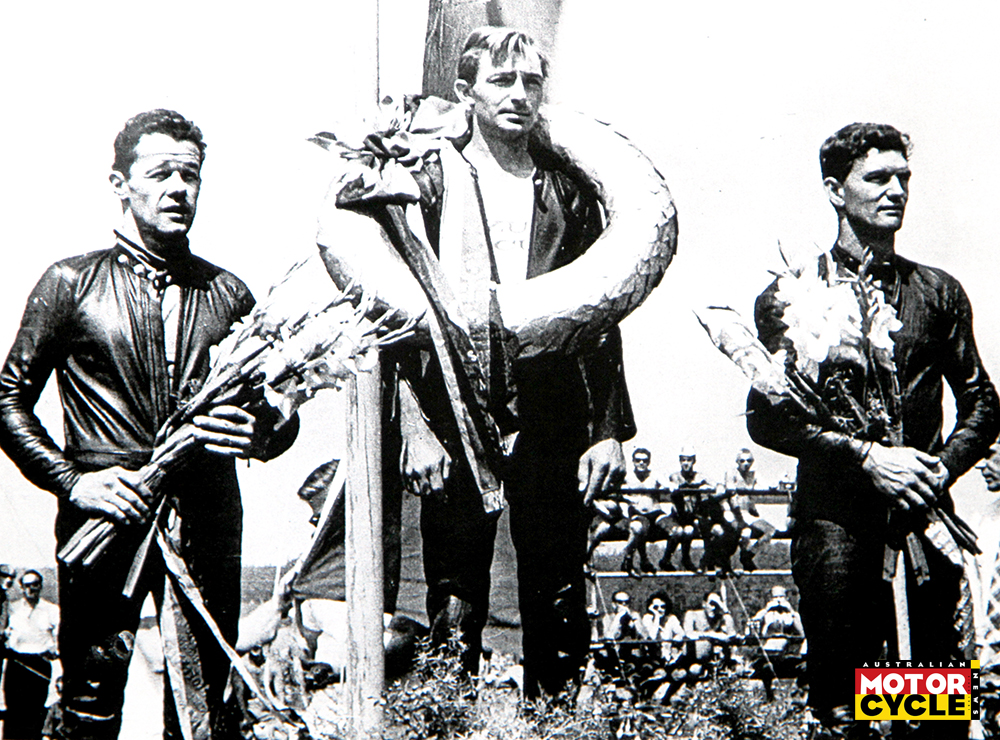
125cc podium at Sachsenring in 1964: (L to R) Luigi Taveri, Anderson and Jim Redman
Clermont-Ferrand in France was the tightest track of the season: “I loved it to bits, and the track went around a volcano with a big drop on one side and a hill on the other side. It had 55 corners and was about five miles long – exactly what I liked. I went there and made up my mind that if I could win the 125 race at Clermont-Ferrand, I could win the world championship. I had come second on the fastest track so all I had to do was come first on the slowest track.
“And that was the transformation in me, I was a changed person from Clermont-Ferrand onwards and that was the secret to it all. That’s what won me the world championship.”
The 1963 125cc title chase also brought Anderson’s first TT victory.
“I knew then that I could win the world championship. I took my form from the French GP and won the Isle of Man and then the Dutch TT, it was all just part of the process.”

Star power: Agostini and Anderson at a classic meeting in 1999
By the close of the 1963 season Anderson had become world champion in the 125cc and 50cc classes. He netted the hard-fought 125cc world title following six victories (France, Isle of Man, Dutch TT, Ulster GP, East Germany & Finland) and two further podiums. He added icing on the Suzuki cake by taking two 50cc wins (West Germany & Argentina) and five more podiums.
Speaking about the 125cc category, “I won the world championship as a result of all the homework and preparation I had done where most of the other riders did nothing.”
1964 brought a year of highs and lows as Anderson successfully defended his world 50cc crown by crossing the line first on four occasions (USA, France, IoM and Finland) and taking another two podiums to notch up world title number three. He also took three 125cc victories in ’64 (USA, East Germany and at the Ulster Grand Prix) plus one podium to complete a problematic season third.
In 1965 Hugh Anderson took seven dominating victories (USA, West Germany, Spain, France, Finland, Nations GP at Monza, Italy and Japan) and one third placing at Assen to win the 125cc world championship, his fourth and final world championship.
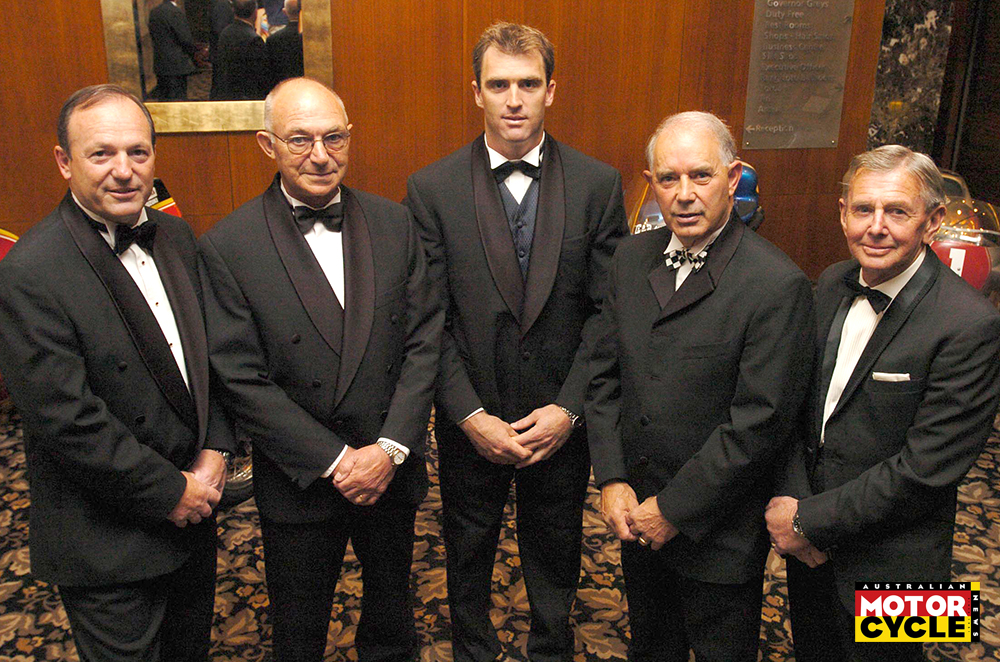
Hugh has been inducted into NZ’s sporting and motorcycling halls of fame
In the 50cc title chase he notched up a single win in Spain and five more podiums to end 1965 third. However, Anderson suffered a very difficult year in ’66. At the East German Grand Prix at Brno his bike was seizing up and oiling plugs still, so the team took the bike out onto the Autobahn.
“I blasted off down the Autobahn and there was a gap in the median strip, so I turned and came tearing back again to have a look at the plugs and there were a couple of cop cars waiting for me. The Japanese mechanic was sitting in the van shaking – they aren’t rule breakers! The cops asked me what the go was, so I told them we have to run the engines in and so on. They asked me how long it would take to fix the problem and I told them about half an hour, so they blocked off the Autobahn for us!”
During the season his Suzuki 125 twin suffered repeated ignition problems, including while leading the Czechoslovakian Grand Prix, dropping Anderson back to fourth. At Finland he was told it was a condenser problem, which Hugh didn’t believe. Sure enough about 10 laps into the race he’s leading and the bike developed another misfire.
Hugh had ultimately lost control of what happened to the engines in the pits, his hard-earned experience was no longer a factor on how to make a reliable race engine.
“[The factory mechanics] hadn’t learnt a thing over all these years, and they were still stuck on bloody piston bore clearances. I decided that I didn’t need this anymore. I was sick of it, I’d had enough. I thought, ‘this isn’t the way to go road racing after all these years’.”
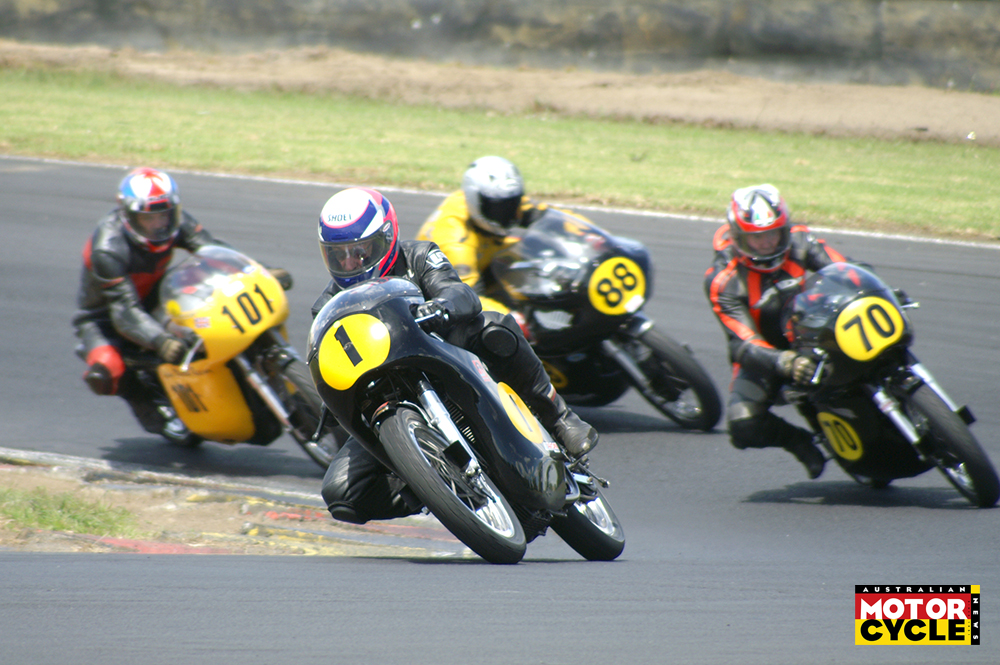
Leading the pack in a classic meeting at Pukekohe in 2007
Classic racer
On arrival back in New Zealand in October 1969, Hugh Anderson organised arguably the first recognised Classic race in the world, run in 1975 at the Hamilton Motorcycle Club’s Founders Theatre street race meeting. As an HMCC member he suggested to race organisers to introduce a classic race for the 1975 programme. He rang a few friends to the point where 35 classic machines were on the start line! So began the throaty roar of single- and twin-cylinder bikes around the world in echoes of past glory, friendship, excitement, and fulfilment.
Anderson went on to become a 19-time NZ title winner and a prominent race meeting organiser during the 1970s and 1980s, and still willingly assists the NZ Classic Motorcycle Racing Register (NZCMRR) and the HMCC clubs with organisational duties. He took up classic motorcycle racing in the 1970s and dominated the NZ Classic championship for a period and also won at many European International Classic meetings.
- At a classic meeting in 1987. Hugh helped kickstart classic racing in the 1970s
- Anderson with his rather immense Isle of Man trophy
He co-founded the NZCMRR in 1979, which became the first nationwide Classic club in the world. His tremendous input then began the hugely popular Classic Festival, held every February at Pukekohe, NZ. Anderson decided to finally call it quits in 2009 after a rider lost control and hit him pretty hard during a Pukekohe race.
Today the 86-year-old lives in Hamilton, NZ, with wife Janny, who he met while in Assen hospital after a 1961 crash. They have three adult children.
An impressive record
Hugh Anderson was made a Member of the Order of the British Empire (MBE) in 1994. In 1995 he was inducted into the NZ Sports Hall of Fame, he had a postage stamp named after him, and in 2005 he was inducted into the Motorcycling NZ Hall of Fame. Anderson released his autobiography Being There in 2014 and remains equal with 1993 world 500cc champion Kevin Schwantz as the most successful Suzuki racer of all time with 25 victories. From only 68 starts Anderson has an astonishing 37% win rate every time he raced in Grand Prix. During his brief six year GP career Anderson earned 47 podium positions and held over 70 lap records on international and NZ circuits.
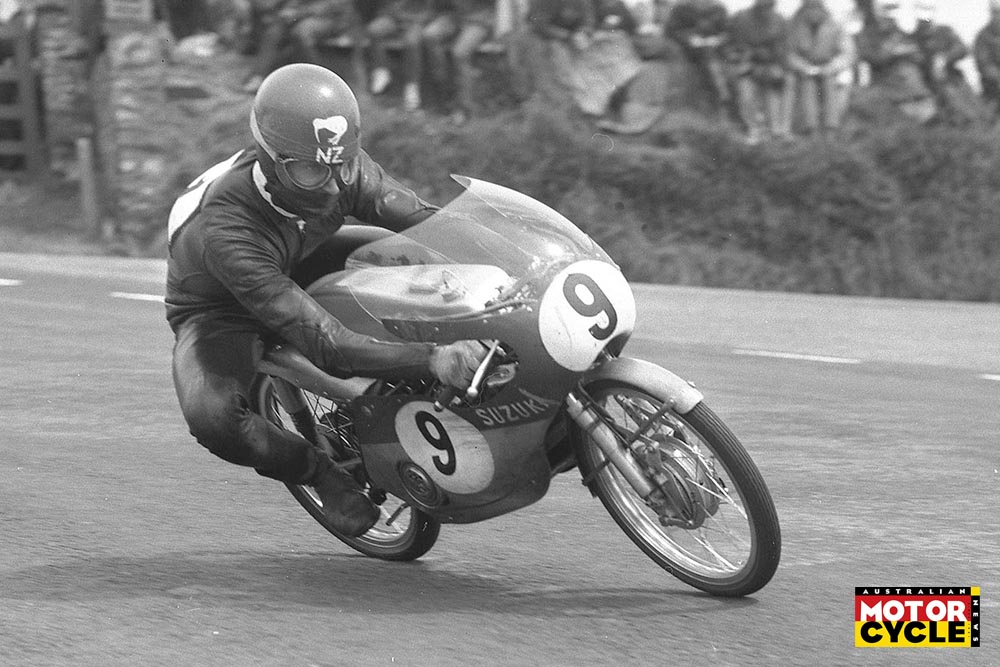
Knee-out action at the Isle of Man on Suzuki’s 50cc machine.
Clearly gifted, Hugh Anderson became a four-time Grand Prix world champion with two 125cc titles (1963 and 1965) and two 50cc world titles (1963 and 1964) to his name. Anderson also won four British championships between 1963 and 1965, plus he is a two-time Isle of Man TT winner (1963 Ultra-Lightweight 125cc TT and 1964 International 50cc TT).
Mr Versatility
Hugh Anderson loved off-road racing and as early as 1962 had suggested to Suzuki it should become involved with developing a motocross bike. Suzuki agreed and in 1962 sent their first example out to New Zealand for Anderson to test privately.
Progress was slow but by 1965 each time Anderson was in Japan he carried out a series of tests. When he retired from road racing at the end of the 1966 season, Anderson had already been competing in international motocross meetings for two years, between road-race events.
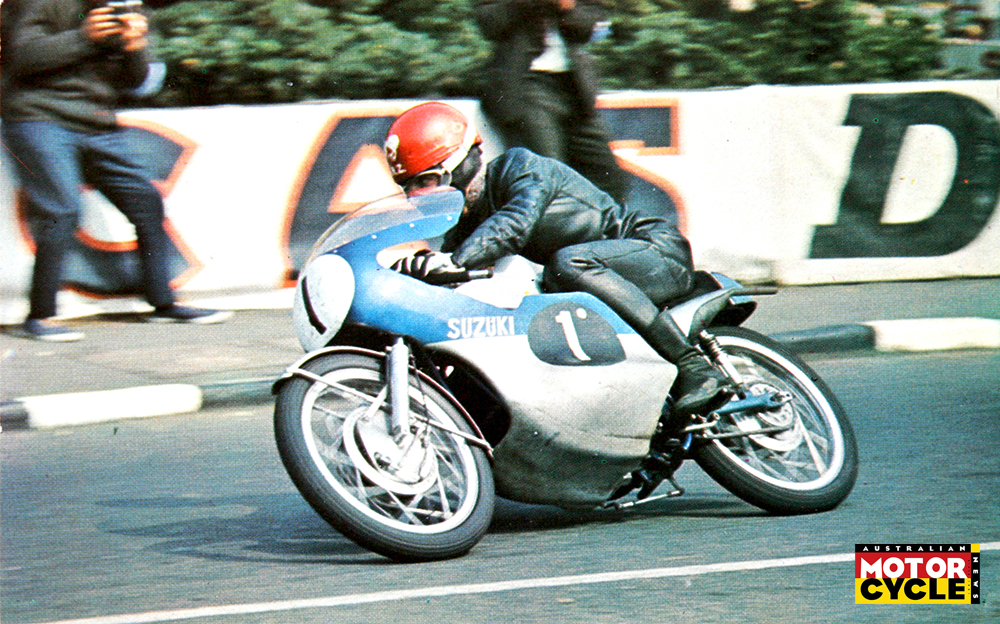
During the 1967 season problems with frame fractures and the fork were sorted, and finally at the last scheduled meeting, Hugh Anderson became the first Suzuki rider to finish a world championship motocross event.
Read about Hugh Anderson’s induction as a MotoGP Legend here.
